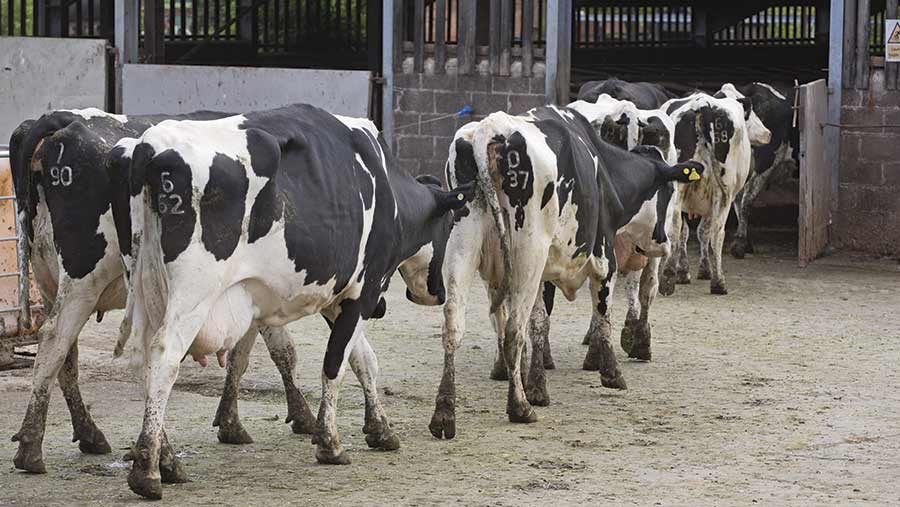4 ways to improve cow flow and reduce lameness
 © Tim Scrivener
© Tim Scrivener Allowing cows time and space and adhering to good routines when walking to the milking parlour improves cow flow and reduces the chance of white line disease and sole injuries, according to one vet.
New Zealand veterinarian and lameness expert Neil Chesterton said achieving good cow flow meant cows were more relaxed and less likely to twist and turn on their hooves.
Speaking at an AHDB Dairy mobility and cow flow meeting at Metcalfe Farms, Washfold Farm, Leyburn, North Yorkshire, Dr Chesterton explained some tell-tale signs that cows weren’t happy which can be spotted in any unit, whether big, small, housed or extensive.
Cow flow and lameness
In pasture-based systems up to half of lame cows can have white line disease. Neil Chesterton’s figures from New Zealand dairies show 42% of lameness incidence to be due to white line and around 29% from sole injury.
“When cow flow is compromised it results in cows twisting and slipping which pulls the sole away from the nail of the hoof creating a place for infection or injury from small stones,” says Mr Chesterton.
“Good cow flow means understanding cows and their behaviour which relieves pressure on the feet. Less pressure on the feet means less lameness.”
1. Watch cow heads: are they up or down?
Cows lift their heads when aroused or frightened and become unable to check their footing meaning increased risk of slipping on concrete or standing on stones on tracks.
Sufficient space is necessary for cows to lift their heads as this is an important way they adjust body shape and redistribute their weight as they walk along.
However, cows walk best with their heads down as this improves cow flow.
Signs to look out for
- Cows walking with their heads down or slipping
Solutions
- Observe the cows for distress signs such as people or dogs which could be pushing them too hard
- Give the cows sufficient space and freedom to move their head when needed
- Ensure cows are not bunched up
- Can they see where they are going?
- Are yards/walkways non-slip?
2. Identify dominant cows
Herds have dominant cows that control the rest and form queues around them, allowing some to go past and choose their ideal time for milking.
Space is critical for cows to exhibit this natural behaviour.
Signs to look out for
- Cows knocking side to side and being bunched together or rushed because they haven’t got sufficient room. This can cause herd dynamics to fail because dominant cows are swept along with the rest, making lower order (less dominant cows) nervous and alert and cow flow becomes hampered
Solution
- Time different people to gather cows in. Are some rushing the herd more than others?
- Experiment with backing gate speeds and frequencies to see which works best.
- Ensure there is sufficient space for cows to walk and stand.
- Holstein-Friesians require 3sq m of loafing area and 1.8m-2m square space (600-650kg cows) in collecting yards, while Jerseys require 1.3sq m in collecting yards.
- Sit in a tractor cab or somewhere out of sight and watch your cows. If you can see dominant cows, stopping, waiting and blocking others cows this is evidence the herd hierarchy is functioning.
- Watch for about 50% of dominant cows in the front third of the walking line and 25% in the middle and last third of the walking line respectively
3. Handle cows with care
Understand cows have a wide 330deg panoramic vision, which means they don’t mind you coming slowly from the front or the side but become frightened when you disappear behind them into their 30deg blind spot.
They also find eye contact threatening from strange people. This causes panic and a flight response leading to twisting feet, slipping and increased likelihood of foot trauma.
Signs to look out for
- Staff approaching cows from behind, making sudden movements, not respecting cow flight zones and offering eye contact.
Solution
- When needing to move cows do so slowly and without sticks.
- Instruct staff to approach cows from the side and understand the cow’s balance point is her shoulder.
- By walking past the shoulder to her rear you make her walk forward
- Train your staff in low-stress handling (basics of flight zones and balance points).
4. Human behaviour
Friendly and familiar people seldom worry cows but there are many ways cows can be upset from unexpected visitors or behaviour.
If someone uses a stick or shouts and waves their arms it can be counterproductive and actually make cows slower. This wastes time and is a threat to a cow making her twist on what are often wet surfaces.
Signs to look out for
- Are cows slipping, dunging, pulling their heads back and needing persuading to go into the parlour or through gates when certain people are around?
Solution
- Explain herd behaviour and dominant cows to your staff.
- Make sure new staff first meet cows during a good experience such as feeding or turnout and not a bad one like hoof-trimming or TB testing
- Get a watch and time different milk shifts, are there differences in staff approach?
